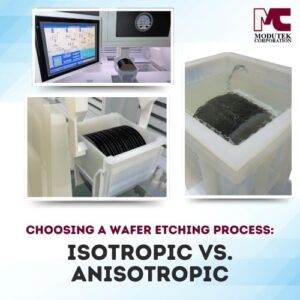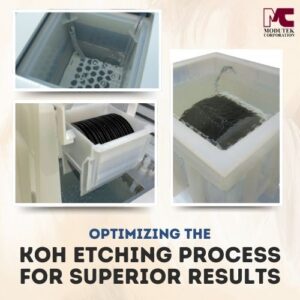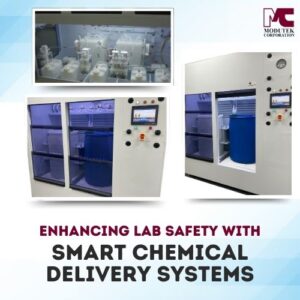![]() Piranha etch is a popular process for silicon wafer cleaning, but it has to be tightly controlled to be effective. The mixture of about one part hydrogen peroxide and three parts sulfuric acid rapidly removes organic matter from silicon wafers. The etch process takes place in heated quartz tanks where both temperature and chemical concentration affect the etch rate.
Piranha etch is a popular process for silicon wafer cleaning, but it has to be tightly controlled to be effective. The mixture of about one part hydrogen peroxide and three parts sulfuric acid rapidly removes organic matter from silicon wafers. The etch process takes place in heated quartz tanks where both temperature and chemical concentration affect the etch rate.
Precise control is difficult because mixing the original solution is exothermic, and the hot mixture is then maintained at between 130 and 180 degrees centigrade. The hydrogen peroxide decays to form water, diluting the mixture. The rate of decay depends on the temperature, but adding extra hydrogen peroxide to keep the concentration steady increases the temperature.
With several key variables interdependent, accurate control with traditional control systems is not easy and results can be varied. The mixture, with periodic addition or spiking with hydrogen peroxide, has a useful life of only about one day. Modutek has developed a control strategy that improves process results while reducing chemical use.
The Modutek “Bleed and Feed” Process Control Strategy Delivers Improved Results
Modutek’s “Bleed and Feed” process control strategy keeps the concentration of the Piranha mixture at the desired level while increasing the lifespan of the mixture. The company uses a two-tank “clean” and “dirty” tank design. When the concentration of hydrogen peroxide in the dirty tank goes down, a small amount of mixture is drained from the tank and is replaced by an equal amount from the clean tank. The clean tank then receives a fresh amount of mixture. The clean tank and dirty tank mixtures and the amounts of the bleed and the feed are all programmable so that the desired concentrations can be maintained for an extended period. Using the “Bleed and Feed” method, the Piranha mixture has a much longer life span.
“Bleed and Feed” Control Strategy Advantages
The control strategy of frequently adding small amounts of a programmable hydrogen peroxide/sulfuric acid mixture to the main “dirty” tank mixture to maintain its concentration provides several advantages to the silicon wafer cleaning process. Instead of spiking the mixture with hydrogen peroxide, the Modutek method adds an already mixed dosage to the main mixture, reducing temperature instability and allowing better control of the process. When the main mixture is relatively stable, it lasts longer and doesn’t have to be replaced as often. The temperatures and concentrations are more stable and the control of the etch or strip rate is more precise.
The Modutek “Bleed and Feed” Process Control Delivers Substantial Benefits
With more precise control of the process and a more stable Piranha mixture, Modutek’s “Bleed and Feed” process control improves Piranha etching results. Specific benefits include the following:
• Better control of the process increases reliability of strip results
• Precise temperature and concentration levels result in a constant strip rate
• Programmable dosage levels add control flexibility for predictable results
• Reproducing process parameters creates excellent repeatability
• Longer mixture life reduces chemical use
• Replacing the mixture less often reduces down time
• Chemical purchase and disposal costs are lower
• Risk of an accident from adding too much hydrogen peroxide is eliminated
Overall process results and wet etching performance are improved with the better outcomes and reduced costs of a Piranha etch process using Modutek’s “Bleed and Feed” process control. Customers incorporating Modutek’s new control strategy can expect reduced product failure rates, better output quality and overall improved wet process station performance.
Modutek continues to improve their silicon wafer cleaning equipment to provide customers with better process results using the “Bleed and Feed” process control in new wet bench stations. The company offers free consulting and can help customers choose an appropriate wet bench configuration or custom-build one to meet specific customer needs.




